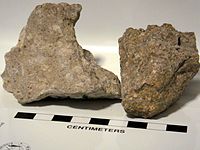
Photo from wikipedia
Crystal aggregates that erupted at Kilauea volcano were formed in the presence of waves inside the conduit before eruption. Developing reliable, quantitative conduit models that capture the physical processes governing… Click to show full abstract
Crystal aggregates that erupted at Kilauea volcano were formed in the presence of waves inside the conduit before eruption. Developing reliable, quantitative conduit models that capture the physical processes governing eruptions is hindered by our inability to observe conduit flow directly. The closest we get to direct evidence is testimony imprinted on individual crystals or bubbles in the conduit and preserved by quenching during the eruption. For example, small crystal aggregates in products of the 1959 eruption of Kīlauea Iki, Hawaii contain overgrown olivines separated by large, hydrodynamically unfavorable angles. The common occurrence of these aggregates calls for a flow mechanism that creates this crystal misorientation. Here, we show that the observed aggregates are the result of exposure to a steady wave field in the conduit through a customized, process-based model at the scale of individual crystals. We use this model to infer quantitative attributes of the flow at the time of aggregate formation; notably, the formation of misoriented aggregates is only reproduced in bidirectional, not unidirectional, conduit flow.
Journal Title: Science Advances
Year Published: 2020
Link to full text (if available)
Share on Social Media: Sign Up to like & get
recommendations!